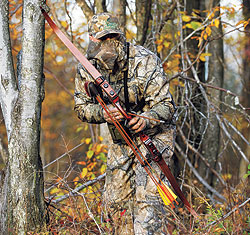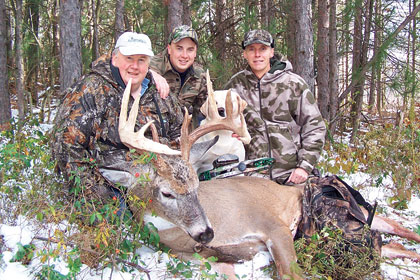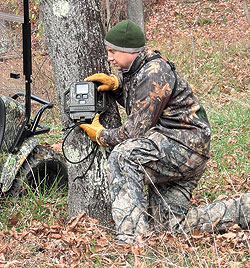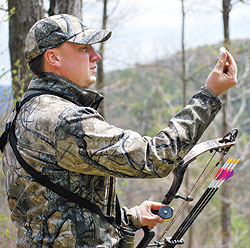October 28, 2010
By Craig Dougherty
Take your hunting higher with a low-impact strategy.
By Craig Dougherty, Neil Dougherty
 You may consider yourself a stealthy still hunter, but it's a sure-fire way to put every mature deer in the area on red alert. Forget about it! |
The largest buck ever taken on our Upstate New York property was killed with a muzzleloader on the last day of gun season. He showed up 10 minutes before dark to load up on frostbitten clover before bedding down for the evening. Blowing snow, 20 degree temps and an empty belly forced him into the open.
We knew he was around but hadn't seen him in a couple years. The last time we saw him was two years prior, when I had him at full draw. We found his sheds two years in a row.
Advertisement
He seemed to be hanging out in a small, 10-15 acre area comprised of dense sanctuary cover, a half-acre food plot and an oak woodlot. Now, the 154-inch, 5€‰1/2-year-old was piled up in the snow 40 yards from the plot. The second mature buck in as many years was proof our management program was working!
That was six years or so ago. Since then, my son Neil and I have taken or passed up mature (5-6-year-old) bucks on our 500-acre property every year. Neil is a wildlife consultant specializing in developing small property for quality deer hunting. Our management program is built around three principles: enhanced habitat management, letting young bucks grow and harvesting does, and practicing "low-impact hunting."
Advertisement
Our program has been successfully implemented on dozens of properties across the country. Hunters and landowners take readily to managing habitat and selectively harvesting deer. But they often have trouble embracing the discipline required to hunt "low impact." The concepts are relatively simple to grasp and absolutely mandatory if you want to consistently take big whitetail bucks with a bow.
 From left, Craig Dougherty, Neil Dougherty and hunting partner Steve Storie pose with a 5 1/2-year-old, 140-class buck Craig took on his 500-acre farm in Upstate New York. Dougherty credits low-impact hunting methods for his ability to consistently harvest mature deer on a relatively small property. |
Learn Your Property
Job one is to learn the property you are hunting; every square inch of it. You can't effectively hunt big bucks if you don't know where they hang and how they travel. You also can't hunt big bucks if you don't know how to set up on them with minimum disturbance.
Topographical maps and aerial photos are a must. Look for out-of-the-way places where big bucks can hole up to avoid pressure. Look for thick cover travel corridors and ridges between these areas and food sources. Check them for stand locations; stands you can get in and out of without disturbing every deer in the area.
You will also need to know precisely how the wind blows and how the big boys use the wind to "see" the property. You need to find where the big boys travel and when. You should establish a network of access trails into hunting setups and stay on them once you start hunting. Scouting camera sites should be located near access trails.
The best time to learn your property is late winter or early spring. Conditions are similar to hunting season, your property will have time to settle down and deer sign is easy to find. Exploring at any time is disruptive, but without this knowledge you are basically hunting by trial and error. Put everything you learn on a map and in a notebook, because from here on in, you are outta there.
Once You Learn It, Stay Out!
Job two is to stay out of the woods. This is the tough part. For some reason, hunters just can't stay out of the woods -- even hunters who know better. Hunters have a horrible habit of screwing up their hunting every year under the guise of pre-season scouting.
They visit the same crossings, walk the same rub lines and visit the same scrapes year after year. They hang stands in the same locations and do a little trail trimming just to be sure every deer in the area knows bow season is a week away.
 Trail camera evidence has convinced Craig Dougherty that noise and fumes from ATVs such as this Argo cause too much disturbance to deer on small properties. He recommends electric-powered golf carts as a better choice for low-impact hunting. |
Some hunters scout in the middle of the day to avoid spooking deer. Forget about it! Our scouting cameras have shown deer on alert 24 hours or more after a hunter laid down tracks in an area. Deer know when you have been in the woods, and big bucks don't know the difference between scouting and hunting. Show up in a slammer buck's back yard, and you'll put him into survival mode. If he doesn't leave immediately, he'll do so as soon as he senses a little hunting pressure.
Low-impact hunters learn their hunting areas, then stay out of them as much as possible.
Big bucks tend to use the same areas year after year. It takes self-discipline and a commitment to "low-impact hunting" to stay out of the woods when the temperature starts to drop and the leaves start to turn.
If you absolutely must be in the woods (that would be me) prior to bow season, find a new area (a mile or more from your primary hunting area) and work it. This will scratch your scouting itch and keep your primary area clean for the upcoming season. It will also keep you supplied with new hunting spots for the future.
We shut down all activity on our property 45-60 days before the opener. No trucks, no tractors, no woodcutting or boundary posting allowed. Did I mention no ATVs or sighting in guns? This is not easy to do with a group of guys who love being in the woods, but if you are hunting small properties and you want big bucks, it's a must.
 Trail cameras are a great, low-impact method for monitoring the deer on your hunting area. Place cameras close to established human access trails and check them o n foot or with a low-impact vehicle such as a bicycle or electric-powered, all-terrain golf cart. |
Take Lots Of Pictures
Scouting cameras have made a huge difference in our program. They make it possible to do much of our scouting on the computer. Our cameras have taught us tons about deer.
We set them up in known travel locations to learn where big bucks are moving and when.
It is amazing how, in just a couple of weeks, you can begin to vector in on a buck's movement patterns by triangulating. If you know your terrain, you can pretty much figure out what a big buck is doing if you can catch him a couple times on a few strategically placed cameras. We check our cameras as little as possible to avoid polluting the area with human scent and always set them up near or on well-established trails so as not to overly alarm deer. We swap memory cards every week or so and shoot roughly 40,000 photos per year. Checking cameras does disturb deer, but information gleaned from them has proven more than worth it
Blowin' In The Wind
Deer use their noses like hunters use their eyes. Many experts believe a mature deer can detect a hunter's scent from half a mile away. It is virtually impossible to beat a mature buck's nose unless you are upwind of him. Wind direction, more than any other variable, dictates how we set up a property and how we hunt it.
 Set up your treestands well in advance of the season. Erecting a stand with your hunting posse a day before the opener will let mature bucks know something is up. |
It's important to keep your scent pollution to a minimum; and we don't mean just washing your clothes and using cover scents. We mean staying away from the upwind side of your property and not hunting an area if the wind is wrong -- even if it means not hunting at all. Small properties can be completely shut down by a hunter who repeatedly hunts the upwind side of the property. A nose full of hunter is all a mature buck needs to go nocturnal or head for the county line.
Air travels across a property like water in a stream. It deflects, doubles back and is channeled by obstructions such as trees, hills and valleys. Air from large expanses of terrain can be squeezed into narrow air corridors. These areas attract savvy bucks looking to check for predators or receptive does without covering a lot of ground.
Toss some wind floaters or blow some bubbles to see how the wind travels across your hunting property. You will be amazed how wind currents move and how broad swaths of air are often collected in narrow funnels. We take time to make wind maps of our properties, which help us determine which stands to hunt in which winds.
We never set up in areas where the wind continually swirls and changes direction, and we stay away from setups that will broadcast our scent across broad expanses of our property. If the wind switches unexpectedly and "queers" a setup, we change stands immediately or quit hunting altogether.
Keep It Quiet
"Low-impact hunters" hunt quietly. Years ago, we convinced ourselves deer got used to certain sounds and we could get away with using ATVs and other vehicles to get to and from stand locations. Boy, were we wrong! Years of watching deer (now with cameras) as trucks and ATVs prowled about have convinced us deer are ultra sensitive to sound and know the difference between a sound that belongs in the woods and one that doesn't.
Car doors clicking, climbers clanking and arrows ticking send warning signals to deer.
We switched to electric golf carts (no smell, no engine noise) a couple years ago for long hauls across our property. They seem to help, but the deer will eventually wise up. One of the best bowhunters I know once walked me for 50 minutes in the pre-dawn dark to enter a property the "right way" for a morning hunt. Was I surprised when we came out of the woods later in the day to be at the trucks in five minutes! Serious bowhunters keep quiet in the woods.
Stay On Established Travel Routes
Deer don't like surprises -- especially mature deer. Establishing a network of access roads and trails on your hunting property will help control hunter movement and avoid surprising deer in their bedrooms. You can't hunt a property without putting boots on the ground, but you can keep disruption to a minimum by staying on well-established human travel trails. Ever see a deer ignore a farmer on a tractor or kids playing in a schoolyard?
Same idea.
Respect Sanctuary Areas
Much of our property has been put off limits to humans. Some of our sanctuaries have not had a human on them in 20 years. Sanctuaries give mature bucks a safe place to hang out, and they know it! Tracks in the snow during gun season tell the tale every year. Rule of thumb: the smaller the property, the higher the percentage that should be dedicated to sanctuary (up to 80 percent for properties under 100 acres). Establishing sanctuaries and staying out will do wonders for your "low-impact" hunting program.
 Keeping the wind in your favor is rule No. 1 of low-impact hunting. Check the wind often, and if things change, get out of there! |
Move In For The Kill
So, how do you kill Mr. Big once you have an idea where he is and what he's doing?
Hunt him only when conditions are perfect for the location you want to hunt him in. That means the wind must be perfect or you don't hunt there. That also means you had a stand rigged (or at least set up for a climber) months in advance, and you can get to it without messing up the area. Move in for the kill and gut it out. Make absolutely no unnecessary trips in and out of the woods.
If you don't kill Mr. Big on your first or second sit and you're hunting a travel route, you should assume he knows something is up. He will leave the area, go nocturnal or keep a nose on you by shifting his travel route downwind of where he suspects you are. If he has shifted his travel pattern, you can often catch him by having a second and even a third "fall back" stand set 100-200 yards downwind from your original stand. We often kill mature bucks as they are swinging downwind of stand locations we recently hunted. If that doesn't work, pull out and regroup until you figure him out again.
When In Doubt, Work The Edges
If you don't know what Mr. Big is up to, chip away at the edges of the general location you believe he is using. Gradually move into what appears to be his core area. Slip in and out of the woods witho
ut making a sound and without stinking up the woods. Keep changing locations so you don't pollute any given stand site while also keeping the pressure to a minimum. Hunt food early in the season and hunt travel routes as the rut approaches. Hunt doe hangouts during the breeding period and get back to hunting food after the rut ends.
Scouting cameras really come in handy when you aren't sure what's going on with Mr. Big. Cameras are on watch 24-7. They enable you to learn a whole lot with a minimum of disturbance. If you don't know where he is and how he is moving, cameras can help.
Whatever you do, if you aren't sure where Mr. Big is hanging out, hunt low impact. No ramming around in the woods, no noise pollution, no hunting when the wind is wrong.
Don't lose your focus and get sloppy. Make one mistake and he is gone -- maybe forever.
Take It To The Extreme
I chuckle when I read about "extreme" bowhunters who spend more time running up and down mountains than they do hunting. I guess the animals they hunt aren't afraid of noise or human scent. Maybe they are just stupid (the animals, that is).
My notion of "extreme hunting" is the discipline and focus you apply to executing your strategy. Low-impact hunting is all about keeping deer calm and keeping mature deer in your area. Low-impact hunting demands discipline, concentration and a willingness to take stealth to the extreme. Low-impact hunting is the ultimate chess game, the ultimate dance between hunter and hunted and the ultimate way to consistently take mature bucks with a bow and arrow.
For more information about Craig and Neil Dougherty's property management techniques, visit their website at www.northcountrywhitetails.com.
